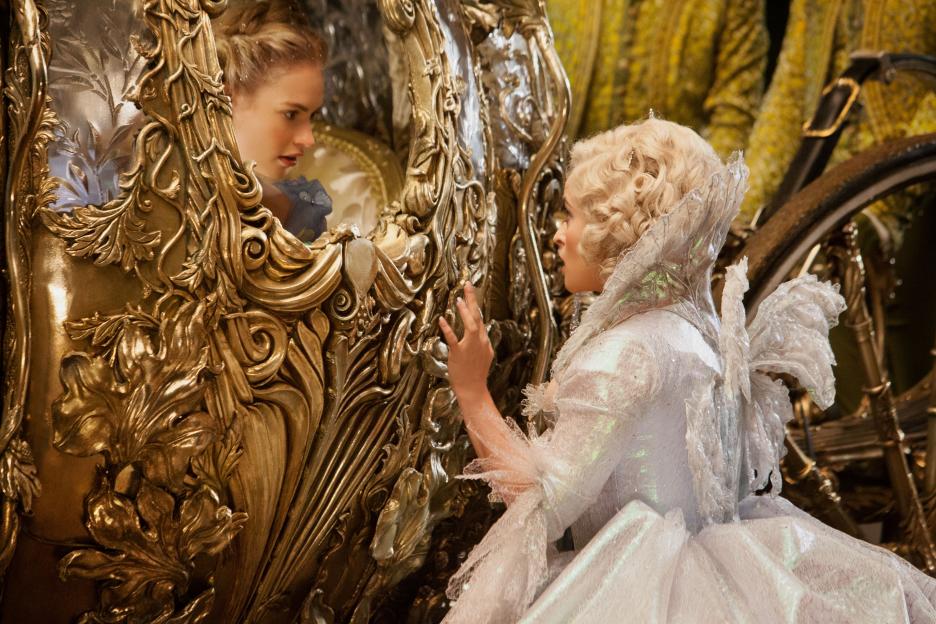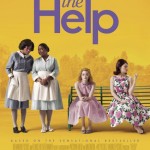
Watch Cinema Siren’s 5 star review below to hear why Disney’s live action Cinderella’s success and beauty is as much or more about the artists behind the scenes as it is the actors and director:
Here is a transcript of the review, with added information about the film:
Do you have a memory as a child of that meadow with butterflies you ran through, or that the taste of that peach straight off the tree so great you can almost still taste it many years later? You know that eye roll you reserve for your idealistic friend who just won’t give up on something no matter how impossible it seems to you? Well get ready to ditch the eye roll and feel like you are surrounded by butterflies. That’s what director Kenneth Branagh, his cast and crew is offering us all with the much anticipated new live action release Cinderella. He’s unabashedly bringing the best kind of Disney joy, and he’s gotten help doing it from the very best folks working in every aspect of filmmaking. The biggest triumph of Cinderella is there isn’t a shred of cynicism, snark, or satire to be found in its 105 minutes, and cinematically that translates to leading audiences through an experience ever more filled with optimism and genuine sweetness. It leaves the kind of inner glow that will almost guarantee beaucoup box office bucks, and much repeat viewing.
That’s ok, unlike Transformers, this movie deserves it.
In the marketing they promote Cinderella as a romantic fantasy, but it isn’t just a romance about two people finding each other. It is full of the romance of approaching life with a desire to find happiness where you are. It is about an honest desire to be good, and the aim to, as the characters in the film say, “have courage, and be kind”, and that is the best kind of inspiration for young boys and girls, as well as jaded grownups even a tiny bit willing to see magic again.
The story of Cinderella needs no synopsis, so well known is it to anyone who has seen the 1950 Disney animated feature, or been read bedtime stories during childhood. As with the 1950 Disney release, this new movie is largely based on French author Charles Perrault’s fairy tale published in 1697.
Cinderella on film has a long and storied history, with the first version created by France’s cinematic treasure George Melies in 1899 and the first Hollywood version made in 1914 with Mary Pickford in the starring role. Thank the fairy godmother that Kenneth Branagh replaced original director Mark Romanek, who wanted to make the story way darker.
While some of the older versions of Cinderella have a cautionary quality embodied in the story (for example, the Brothers Grimm version have the stepsisters cutting off toes trying to fit the glass slipper), the 1950 animated feature had another message. It was released soon after World War II soldiers had gotten back and reentered the work force, and one of the reasons for its success at the time is the representation of the lead character as an average person who can make anything happen through hard work, optimism, and determination. Basically the postwar desire for a “chicken in every pot”, and the need to approach life with positivity, helped make it the first big hit for Disney since 1937’s Snow White. That makes the screenplay by Chris Weitz, Branagh’s direction, and the team making the visual and technical choices through the art direction, production and costume design, all as perfect a fit as the glass slipper on a would-be princess.
To carry on the legacy of Disney’s 1950 animated version of Cinderella in particular, costume and production design are absolutely essential elements for capturing its fairy tale spirit. In fact anyone who knows about animation art is aware that Cinderella in her ballgown and the coach that carries her to the ball are two of the most desired scenes requested by collectors. There was an immense amount of design and meticulous artistry that went into both those elements in that cartoon classic. It is gratifying to see Branagh and his production partners, production designer Dante Ferretti, cinematographer Haris Zambarloukos, and costume designer Sandy Powell, come together to create such seamless artistry, allowing all those elements to shine on their own as well as in the service of the film as a whole. There isn’t a place you’ll look that isn’t beautiful. Even the limited worlds of the attic garret, cellar, and work room, to which Ella is relegated by her stepmother, are used to visually show her ways of finding simple joys and staying positive.
Production designer Ferretti, a three time Oscar winner for Hugo, Sweeney Todd, and The Aviator, knows about creating lush and visually opulent alternate worlds. For Cinderella he designed a wonderful series of real sets, environments, and props. The most memorable item he shepherded into being was Cinderella’s iconic coach. He started with the idea that Cinderella herself was a jewel. He imagined her glowing from within another jewel that would be the coach. He used precious antique jewel boxes as inspiration, and the breathtaking final design was translated into 2 tons of metal, and painted sparkling gold. For the ball with the prince and Ella’s first dance, Ferretti designed a three story, 50-yard long ballroom that took up almost the entire Bond soundstage at Pinewood Studios. The curtains alone used over 2000 yards of fabric. Remember to look for one of the 17 chandeliers holding 5000 oil candles handmade in Venice. What Ferretti does is knit together the flamboyance of 50s MGM musicals with a reimagined live action version of the 1950 cartoon. The interiors of Ella’s house have hand-created wallpapers, and nicknacks brought home from her merchant father. These are all things worth noting, and worth seeking out during the film. All this is aided by the brilliance of Zambarloukos’s photographic work. It wasn’t shot digitally and he used special film which captured the visual style of the wide-screen CinemaScope so popular in the classic and opulent 50s musicals. His spectacular results are the biggest argument for continuing the use of traditional film in Hollywood.
Of all princesses in Disney history, Cinderella and Belle from Beauty and the Beast have the most dramatic and recognizable costumes. If there was ever a costumer who deserves credit for a film’s success, recognition, it’s 3 time Oscar winner Sandy Powell. Awarded for The Young Victorians, Shakespeare in Love, and The Aviator, it still seems Cinderella’s cinematic aesthetic is the most anchored in the costumes of all her films.
Ella’s two jaw dropping costumes are her ballgown and her wedding dress, but even her everyday working attire is also likely to elicit much cosplaying. Powell created nine different versions of the ballgown, and each featured 10,000 Swarovski crystals and 270 yards of fabric. Somehow she was able to engineer it to be visually voluminous, yet light enough for Ella to run from the ball. The wedding gown, which is my favorite of all the movie’s costumes, has hand painted flowers that took 16 people 550 hours to finish.
Cate Blanchett’s costumes were based on images of 1940s screen actresses like Marlene Dietrich and Joan Crawford, and they used lighting design to accentuate sharp lines and shadows to make the character more terrifying. An expert in designs for men on film, Powell was determined not to have Cinderella get all the costume attention, so hottie prince Kat aka Richard Madden’s uniform for the ball cleverly had shades of blue dyed to accentuate his eyes.
As to the cast, all those chosen inhabit their roles perfectly. Cate Blanchett obviously revels in bringing a more complicated portrayal to Lady Tremaine. She was the first actor to sign on for the film, partly because she is such a fan of the story of Cinderella. She brings an inexplicable sympathy, playing the woman as a widow trying to drown her grief by treating those around her like pawns and playthings. Lilly James as Ella exudes an ethereal innocence and compassion that instantly makes the character sympathetic and likable. She is able to speak lines most would unknowingly tinge with sarcasm. In this version of the story, the prince (Richard Madden), who calls himself Kit when he meets Ella, has a beautiful and deep relationship with his father the king, played by stage and screen great, Derek Jacobi. It is in the scenes featuring Madden and Jacobi that both characters are able to shine, giving a deeper, welcome added element to the story as a whole. Helena Bonham Carter is seen only briefly as the fairy godmother, but as ever she makes the most of her screen time. Notice how she can act through the limited movement her tight corset and highly detailed crystal-laden dress allow. There should be an award for best performance while barely able to breathe.
Branagh takes the reigns as director, but the aforementioned technical film professionals chosen for Cinderella represent some of the best artists working in the world today, in any genre. I dare you to see this movie and still harbor any part of a belief that the art behind the scenes, that which is only seen around the actors so routinely lauded and credited with a film’s success, is any less important to its beauty. There is also something wonderful about purely positive messages devoid of cynicism. That’s what you get with Cinderella 2015, and it leaves you sparkling like 10,015 crystals.
5 out of 5 stars.




